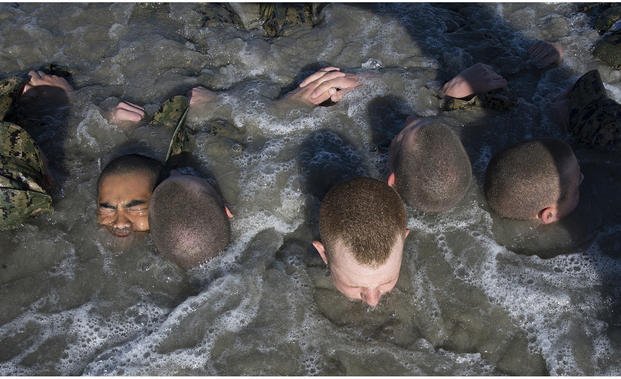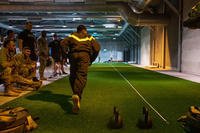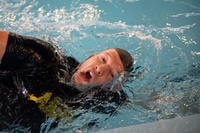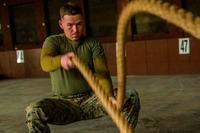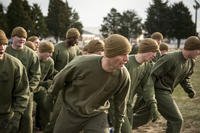This warning order is a course description of BUD/S, or Basic Underwater Demolition/SEAL, training. There is some very valuable information in this warning order on subjects such as a course description on all three phases of BUD/S, workouts to get you prepared for the physical stresses of BUD/S and helpful hints on nutrition. The BUD/S warning order is designed to prepare any highly motivated individual, regardless of athletic history, for the toughest military training in the world.
History
Sea-Air-Land (SEAL) teams trace their history back to the first group of volunteers selected from the Naval Construction Battalions in the spring of 1943. Their mission was clearing obstacles from beaches chosen for amphibious landings. Thus, the first formal training of the naval combat demolition units (NCDUs) began. The NCDUs distinguished themselves at Utah and Omaha beaches in Normandy and southern France.
In the Pacific, the NCDUs were consolidated into underwater demolition teams (UDTs). The newly formed UDTs saw action in every corner of the Pacific during World War II. In September 1950, the UDTs participated in the Korean War at Inchon, Wonsan, Iwon and Chinnampo. The redeployment of the United Nations Forces featured the UDTs conducting delaying operations and using guerrilla warfare.
In January 1962, the first SEAL teams were commissioned to conduct unconventional warfare, counter-guerrilla warfare and clandestine operations in maritime and riverine environments. These teams were SEAL Team One on the West Coast and SEAL Team Two on the East Coast. During Vietnam, the SEALs compiled an impressive record of combat success. Since the close of the Vietnam conflict, the ever-changing world situation and increased operational tasking have prompted the expansion of SEAL teams in number, size and capabilities.
To respond effectively to this evolutionary process, UDTs have been redesignated SEAL or SEAL delivery vehicle teams. Thus, the newly designated SEAL teams acquired the SEAL mission and retained the amphibious support mission inherited from their UDT forefathers.
SEAL and SEAL delivery vehicle (SDV) teams and special boat units comprise the elite combat units of naval special warfare. These units are organized, trained and equipped to conduct special operations, unconventional warfare, foreign internal defense and clandestine operations in maritime and riverine environments. These highly trained specialists are deployed worldwide in support of fleet and national operations. The wide range of tasks performed by naval special warfare and their outstanding combat records have earned an enduring and highly respected reputation.
Find Available Special Operations Opportunities
Naval special warfare extends a personal challenge to those interested individuals like yourself. This program will push you to your limits until you are hard and strong, both physically and mentally, and ready for the adventure of a lifetime in the SEAL teams. Freefall parachuting at 10,000 feet into the ocean at night, traveling by small rubber boat for 100 miles, conducting a mission, then traveling 30 miles out to sea to rendezvous with a submarine is a typical mission for the SEALs. It is an adventure most people can experience only by reading a book. So if you are ready for a challenge and an adventure, the Navy has just the training to test your mettle.
As a BUD/S student, you will participate in challenging training and encounter opportunities to develop and test your stamina and leadership. BUD/S training is extremely thorough, but through adequate preparation and a positive attitude, you can meet its challenges with confidence. The workout schedules in this booklet are designed to prepare you physically for BUD/S. You are the one who has to prepare to give your all every day. It is essential to live, eat and sleep BUD/S. BUD/S is a challenge, but if you meet it head-on with determination not to fail or quit, it will be the most rewarding time of your life. Good luck.
Course Description
First Phase (Basic Conditioning)
First Phase is nine weeks in length. Continued physical conditioning in the areas of running, swimming and calisthenics grow increasingly harder as the weeks progress. Students will participate in weekly four-mile timed runs in boots and timed obstacle courses, swim distances up to two miles wearing fins in the ocean and learn small-boat seamanship.
The first five weeks of First Phase prepare you for the sixth week, better known as "Hell Week." During this week, students participate in 5½ days of continuous training, with a maximum of four hours of sleep. This week is designed as the ultimate test of one's physical and mental motivation while in First Phase.
Hell Week proves to those who make it that the human body can do 10 times the amount of work the average man thinks possible. During Hell Week, you will learn the value of cool-headedness, perseverance and, above all, teamwork. The remaining three weeks are devoted to teaching various methods of conducting hydrographic surveys and how to conduct a hydrographic chart.
Second Phase (Diving)
After completing the First Phase, you have proven to the instructors that you are motivated to continue more in-depth training. The diving phase lasts seven weeks. During this period, physical training continues, but the times are lowered for the four-mile runs, two-mile swims and the obstacle course.
Second Phase concentrates on combat SCUBA (self-contained underwater breathing apparatus). Students are taught two types of SCUBA: open circuit (compressed air) and closed circuit (100% oxygen). An emphasis is placed on long-distance underwater dives, with the goal of training students to become basic combat divers and using swimming and diving techniques as a means of transportation from their launch point to their combat objective. This is a skill that separates SEALs from all other Special Operations forces.
Third Phase (Land Warfare)
The demolitions, reconnaissance and land warfare phase lasts nine weeks. Physical training continues to become more strenuous as the run distances increase and the minimum passing times are lowered for the runs, swims and obstacle course. The Third Phase concentrates on teaching land navigation, small-unit tactics, patrolling techniques, rappelling, infantry tactics and military explosives. The final five weeks of Third Phase are spent on San Clemente Island in California, where students apply techniques acquired throughout training in a practical environment.
Post-BUD/S Schools
BUD/S graduates receive three weeks of basic parachute training at the Army Airborne School at Fort Benning, Georgia, before reporting to their first Naval Special Warfare Command. Navy corpsmen who complete BUD/S and Basic Airborne Training also attend two weeks of Special Operations Technician Training at the Naval Special Warfare Center, Coronado, in California. During this course, they participate in intense instruction in diving medicine and medical skills called 18-D (Special Operations Medical Sergeant Course). It is a 30-week course where students receive training in burns, gunshot wounds and trauma.
After assignment to a team and successfully completing a six-month probationary period, qualified personnel are awarded a SEAL Naval Enlisted Classification (NEC) Code and the Naval Special Warfare insignia. New combat swimmers serve the remainder of their first enlistment (2½-3 years) in either an SDV or SEAL team. Upon reenlistment, members may be ordered to additional training and another SDV or SEAL command, where they will complete the remainder of a five-year sea tour. Advanced courses include SDV training, diving supervisor, language training and NAVSPECWAR communications. Shore duty opportunities are available in research and development, instructor duty and overseas assignments. Besides normal pay allowances, Naval Special Warfare personnel currently receive $175/month in dive pay and $110/month in hazardous duty pay.
Physical Fitness Standards
First Phase
- 50-meter underwater swim (pass/fail)
- Drownproofing test (pass/fail)
- Basic lifesaving test (pass/fail)
- Half-mile pool swim w/o fins (completion)
- Three-quarter-mile pool swim w/o fins (completion)
- One-mile pool swim w/o fins (60 minutes)
- One-mile bay swim w/o fins (70 minutes)
- One-mile bay swim with fins (50 minutes)
- 1½-mile ocean swim with fins (75 minutes)
- Two-mile ocean swim with fins (95 minutes)
- Four-mile timed run (32 minutes)
- Obstacle course (15 minutes)
Second Phase
- Two-mile ocean swim with fins (75 minutes)
- Four-mile timed run (29:20)
- Obstacle course (11 minutes)
- 5½-mile ocean swim with fins (completion)
Third Phase
- Obstacle course (10:30)
- Four-mile timed run (28 minutes)
- 14-mile run (completion)
- Two-mile ocean swim with fins (70 minutes)
Academic standards required on written tests before graduation from BUD/S are:
- 80% or above for officers
- 70% or above for enlisted
The following workouts are designed for two categories of people: Category I are those future BUD/S students who never have or have not been recently on a routine PT program. Category II is designed for high school and college athletes who have had a routine PT program. Usually athletes in sports that require a high level of cardiovascular activity are in Category II. Swimming, running and wrestling are good examples of such sports.
Workout for Category I
Running: The majority of the physical activities you will be required to perform during your six months of training at BUD/S will involve running. The intense amount of running can lead to overstress injuries of the lower extremities in trainees who arrive not prepared physically to handle the activities. Swimming, bicycling and lifting weights will prepare you for some activities at BUD/S, but only running can prepare your lower extremities for the majority of them. You also should run in boots to prepare your legs for the daily running in boots at BUD/S.
The goal of the Category I student is to work up to 16 miles per week of running, After you have achieved that goal, then continue on to the Category II goal of 30 miles per week. Let me remind you that Category I is a nine-week buildup program. Follow the workout as best you can, and you will be amazed at your progress.
Running Schedule I:
- Weeks #1, 2: Two miles/day, 8:30 pace, M/W/F (six miles/week)
- Week #3: No running. High risk of stress fractures.
- Week #4: Three miles/day, M/W/F (nine miles/week)
- Weeks #5, 6: 2/3/4/2 miles, M/Tu/Th/F (11 miles/week)
- Weeks #7, 8: 3/4/5/2 miles, M/Tu/Th/F (14 miles/week)
- Week #9: Same as #7, 8 (14 miles/week)
Physical Training Schedule I:
(Mon/Wed/Fri)
Sets of repetitions:
- Week #1: 4 x 15 push-ups
- Week #2: 5 x 20 push-ups
- Week #3, 4: 5 x 25 push-ups
- Weeks #5, 6: 6 x 25 push-ups; 4 x 20 sit-ups, 3 x 3 pull-ups, 2 x 8 pull-ups
- Weeks #7, 8: 6 x 30 push-ups, 5 x 20 push-ups, 3 x 3 pull-ups, 2 x 10 pull-ups
- Week #9: 6 x 30 push-ups, 5 x 25 push-ups, 3 x 4 pull-ups, 3 x 10 pull-ups
*Note: For best results, alternate exercises. Do a set of push-ups, then a set of push-ups, followed by a set of pull-ups, immediately with no rest.
Swimming Schedule I:
(sidestroke with no fins 4-5 days a week)
- Weeks #1, 2: Swim continuously for 15 minutes
- Weeks #3, 4: Swim continuously for 20 minutes
- Weeks #5, 6: Swim continuously for 25 minutes
- Weeks #7, 8: Swim continuously for 30 minutes
- Week #9: Swim continuously for 35 minutes
*Note: If you have access to a pool, swim every day available. Four to five days a week and 200 meters in one session is your initial workup goal. Also, you want to develop your sidestroke on both the left and the right side. Try to swim 50 meters in one minute or less.
Workout for Category II:
Category II is a more intense workout designed for those who have been involved with a routine PT schedule or those who have completed the requirements of Category I. Do not attempt this workout schedule unless you can complete the week #9 level of Category 1 workouts.
Running Schedule II:
(M/Tu/Th/F/Sat) Total
- Weeks #1, 2: (3/5/4/5/2 miles) 19 miles/week
- Weeks #3, 4: (4/5/6/4/3 miles), 22 miles/week
- Week #5: (5/5/6/4/4 miles), 24 miles/week
- Week #6: (5/6/6/6/4 miles), 27 miles/week
- Week #7: (6/6/6/6/6 miles), 30 miles/week
*Note: For weeks #8-9 and beyond, it is not necessary to increase the distance of the runs; work on the speed of your six-mile runs and try to get them down to 7:30 per mile or lower. If you wish to increase the distance of your runs, do it gradually but no more than a one-mile-per-day increase for every week beyond week #9.
PT Schedule II:
(Mon/Wed/Fri)
Sets of repetitions
- Week #1, 2: 6 x 30 push-ups, 6 x 35 push-ups, 3 x 10 pull-ups, 3 x 20 dips
- Week #3, 4: 10 x 20 push-ups, 10 x 25 push-ups, 4 x 10 pull-ups, 10 x 15 dips
- Week #5: 15 x 20 push-ups, 15 x 25 push-ups, 4 x 12 pull-ups, 15 x 15 dips
- Week #6: 20 x 20 push-ups, 25 x 25 push-ups, 5 x 12 pull-ups, 20 x 15 dips
These workouts are designed for long-distance muscle endurance. Muscle fatigue gradually will take longer to develop during high-repetition workouts. For best results, alternate exercises each set in order to rest that muscle group for a short time. The above exercises can get a bit boring after a while. Here are some more workouts you can use to break up the monotony.
Pyramid workouts
You can do this with any exercise. The object is to build up slowly to a goal, then build back down to the beginning of the workout. For instance, pull-ups, push-ups, push-ups and dips can be alternated as in the above workouts, but this time choose a number to be your goal and build up to that number. Each number counts as a set. Work your way up and down the pyramid.
For example, say your goal is "five."
Number of repetitions:
- Pull-ups: 1, 2, 3, 4, 5, 4, 3, 2, 1
- Push-ups: 2, 4, 6, 8, 10, 8, 6, 4, 2 (2 x #pull-ups)
- Push-ups: 3, 6, 9, 12, 15, 12, 9, 6, 3 (3 x #pull-ups)
- Dips: same as push-ups
Swimming Workouts II:
(4-5 days/week)
- Weeks #1, 2: Swim continuously for 35 minutes.
- Weeks #3, 4: Swim continuously for 45 minutes with fins.
- Weeks #5: Swim continuously for 60 minutes with fins.
- Weeks #6: Swim continuously for 75 minutes with fins.
*Note: To reduce initial stress on your foot muscles when starting with fins, alternate swimming 1,000 meters with fins and 1,000 meters without them. Your goal should be to swim 50 meters in 45 seconds or less.
Stretch PT:
Since Mon/Wed/Fri are devoted to PT, it is wise to devote at least 20 minutes on Tue/Thu/Sat to stretching. You should always stretch for at least 15 minutes before any workout; however, just stretching the previously worked muscles will make you more flexible and less likely to get injured.
A good way to start stretching is to start at the top and go to the bottom. Stretch to tightness, not to pain; hold for 10-15 seconds. Do not bounce. Stretch every muscle in your body from the neck to the calves, concentrating on your thighs, hamstrings, chest, back and shoulders.
Nutrition:
Proper nutrition is extremely important now and especially when you arrive at BUD/S. You must make sure you receive the necessary nutrients to obtain maximum performance output during exercise and to promote muscle/tissue growth and repair. The proper diet provides all the nutrients for the body's needs and supplies energy for exercise. It also promotes growth and repair of tissue and regulates bodily functions. The best source of energy for the BUD/S student is carbohydrates. The best sources of complex carbohydrates are potatoes, pasta, rice, fruits and vegetables. These types of foods are your best sources of energy.
Carbohydrates, protein and fat are the three energy nutrients. All three can provide energy, but carbs are the preferred source of energy for physical activity. It takes at least 20 hours after exhaustive exercise to restore muscle energy completely, provided 600 grams of carbohydrates are consumed per day. During successive days of heavy training, such as you will experience at BUD/S, energy stores before each training session become progressively lower. This is a situation in which a high carbohydrate diet can help maintain your energy.
The majority of carbohydrates should come from complex carbohydrate foods that include bread, crackers, cereal, beans, peas, starchy vegetables and other whole grain or enriched grain products. Fruits also are loaded with carbohydrates. During training, more than four servings of these food groups should be consumed daily.
Water is the most important nutrient you can put in your body. You should be consuming up to four quarts of water daily. It is very easy to become dehydrated at BUD/S, so it is extremely important to hydrate yourself. Drink water before you get thirsty. Alcohol, caffeine and tobacco increase your body's need for water, so if you are going to drink, do so in moderation. Too much of those substances definitely will harm your body and hinder your performance. Taking vitamin supplements has not been proven to be beneficial. If you are eating a well-balanced diet, there is no need to take vitamins.
Training Table Concept
Nutrient intake
- Carbohydrates = 50%-70% of calories
- Protein = 10%-15% of calories
- Fats = 20%-30% of calories
You want to reduce cholesterol intake, found in animal fats and even fish. You need at least 3,500-4,000 calories per day.
In-service candidates’ requirements and procedures for BUD/S training application:
Package requirements:
1. Put in a "special request chit" through your chain of command requesting BUD/S training.
2. Submit a "personal action request" (Form 1306/7) to SPECWAR/diver assignment.
Submit the following with your request:
a. A certified copy of your ASVAB test scores
b. Your physical screening test results
c. Pressure and oxygen tolerance test results (if completed)
d. Your completed diving physical (Form SF88-SF93)
e. Certified copy of your latest performance evaluation report
Physical/Mental Requirements:
1. Pass a diving physical exam
2. Eyesight cannot be worse than 20/40 in one eye and 20/70 in the other eye and must be correctable to 20/20 with no color blindness
3. Minimum ASVAB score: VE AR = 104, MC = 50
4. Must be 28 years old or less
You must be able to pass this physical screening test:
1. 500-yard swim using breast and/or side stroke in 12:30
Ten-minute rest
2. Perform minimum of 42 push-ups in two minutes
Two-minute rest
3. Perform minimum of 50 push-ups in two minutes
Two-minute rest
4. Perform at least six pull-ups, no time limit
No time limit
5. Run 1.5 miles wearing boots and pants in 11:30
*As a reminder, there are no maximums on these physical tests. Prospective trainees should provide the best scores possible, i.e., give their best effort.
Related Navy Special Operations articles:
- Navy SEAL fitness test
- How to prepare for BUD/S
- Video: SEAL BUD/S training
- Getting fit for SEAL Training
- The complete guide to Navy SEAL Fitness
- Joining Naval Special Operations
- Top things to know before BUD/S
- Navy SWCC fitness training
- All Navy Special Operations fitness
Stew Smith is a former Navy SEAL and fitness author certified as a Strength and Conditioning Specialist (CSCS) with the National Strength and Conditioning Association. Visit his Fitness eBook store if you're looking to start a workout program to create a healthy lifestyle. Send your fitness questions to stew@stewsmith.com.
Want to Learn More About Military Life?
Whether you're thinking of joining the military, looking for fitness and basic training tips, or keeping up with military life and benefits, Military.com has you covered. Subscribe to Military.com to have military news, updates and resources delivered directly to your inbox.
